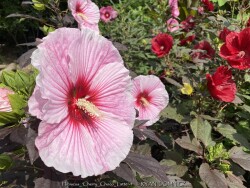
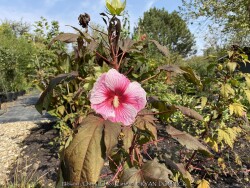
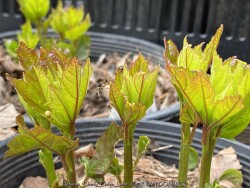
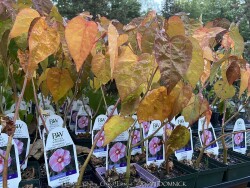
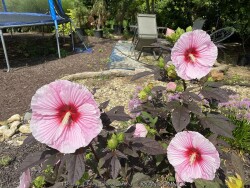
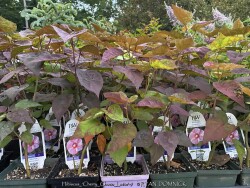
Plant Min Zone: 4b
Plant Max Zone: 9b
Sunlight: All Day Full Sun, Full Sun
Water / Rainfall: Average, High, Very High
Soil Quality: Average, Rich
Bloom Season: Summer, Late Summer, Fall
Flower Color: Pink, Red, White, Multi-Colored
Berry / Fruit Color: None
Spring Foliage Color: Reddish Purple
Summer Foliage Color: Purplish Green
Fall Foliage Color: Reddish Purple, Orange, Red
Evergreen Foliage: No
Winter Interest: Some
Scented Flowers: No
Drought Tolerance: Medium
Wet-Feet Tolerance: High
Humidity Tolerance: High
Wind Tolerance: Low, Medium
Poor Soil Tolerance: Clay Soils, Rocky Soils
Height: 3' - 4'
Width: 3' - 4'
Growth Rate: Medium
Service Life: Long: 5-10 years
Maintenance Need: Low
Spreading Potential: Medium
Yearly Trimming Tips: Trim Perennial to Ground in Early Winter After Hard Freezes: Some Winter Interest.
Plant Grouping Size: Specimen Planting of 1-3, Small Grouping of 3-5
Best Side of House: South Exposure, West Exposure, East Exposure
Extreme Planting Locations: Base of Retaining Wall Locations
Ornamental Features: Multiple Seasons of Interest, Long Blooming Season, Long Lasting Fall Color, Large Tropical Foliage / Flowers, Exceptional / Colorful Foliage
Special Landscape Uses: None
Possible Pest Problems: Beetles, Foliage Disease
Plant Limitations: Needs Thick Winter Mulch, Needs Regular Irrigation, Late to Emerge or Leaf Out in Spring
Shippable in 2026: YES
Hardy Hibiscus are US native plants that feature very large single petal flowers sometimes as large as a dinner plate. Colors include white, pink, red, magenta, purple with many different combinations. Foliage can range from green to reddish to dark purplish black. Hardy hibiscus breeding to produce improved cultivars has come a long way in the last 10 or 20 years. Hibiscus emerge later than most other perennials, needing the ground to heat up before growing in May. Hibiscus tolerate a wide range of soil conditions including clay and wetness but prefer rich garden soil. Drought is tolerated with established plants although flowering will be reduced. Generally, the 40 inches of rainfall in Eastern Kansas is sufficient. Full sun is best for optimal foliage coloring, growth habit, and flowers. When used in a landscape, hibiscus brings a tropical feel when flowering and are noticeable from very far away. Combine with hardy bananas (musa basjoo) and other contrasting flowers. Groupings of hibiscus are very effective around water gardens, rain gardens, backyard fences, pollinator gardens, and roadside areas where you only have a second to look when driving by. Modern hibiscus cultivars do not set seed and do not need to be deadheaded like old varieties; the result is continuous blooming from July till September. Cool autumn nights below 50 degrees F initiate beautiful fall foliage colors ranging from red and purple to fiery orange. Maintenance is pretty easy: just cut down dead stocks to the ground at some point in fall or winter. A yearly time-release fertilizer is appreciated from most heavily flowering plants. There are some occasional foliage pests for hibiscuses including leaf miners, grasshoppers, and Japanese beetles but these can be treated. If not treated, it generally won't kill the plant, especially if the plant is otherwise healthy and in good growing conditions. Summerific® 'Cherry Choco Latte' Hibiscus(Hibiscus 'Cherry Choco Latte') is a brand new, long blooming Hibiscus with a smaller size that is more suitable for tighter spaces. This is a recent Walters Gardens Inc. plant introduction. A perfect late summer perennial! Very large, 8-9" three-dimensional flowers are white with intense deep pink veining and a notably large red eye. Attractive dark olive green foliage forms a compact airy clump. All Proven Winners® plants are legally propagated, healthy and vigorous, true to name, and tagged with color pictures and growing information.